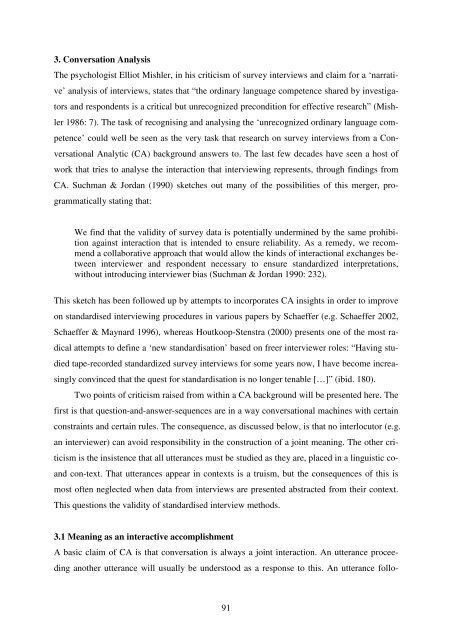Hør dog hvad de siger - Note-to-Self: Trials & Errors
Hør dog hvad de siger - Note-to-Self: Trials & Errors
Hør dog hvad de siger - Note-to-Self: Trials & Errors
Create successful ePaper yourself
Turn your PDF publications into a flip-book with our unique Google optimized e-Paper software.
3. Conversation Analysis<br />
The psychologist Elliot Mishler, in his criticism of survey interviews and claim for a ‘narrati-<br />
ve’ analysis of interviews, states that “the ordinary language competence shared by investiga-<br />
<strong>to</strong>rs and respon<strong>de</strong>nts is a critical but unrecognized precondition for effective research” (Mish-<br />
ler 1986: 7). The task of recognising and analysing the ‘unrecognized ordinary language com-<br />
petence’ could well be seen as the very task that research on survey interviews from a Con-<br />
versational Analytic (CA) background answers <strong>to</strong>. The last few <strong>de</strong>ca<strong>de</strong>s have seen a host of<br />
work that tries <strong>to</strong> analyse the interaction that interviewing represents, through findings from<br />
CA. Suchman & Jordan (1990) sketches out many of the possibilities of this merger, pro-<br />
grammatically stating that:<br />
We find that the validity of survey data is potentially un<strong>de</strong>rmined by the same prohibition<br />
against interaction that is inten<strong>de</strong>d <strong>to</strong> ensure reliability. As a remedy, we recommend<br />
a collaborative approach that would allow the kinds of interactional exchanges between<br />
interviewer and respon<strong>de</strong>nt necessary <strong>to</strong> ensure standardized interpretations,<br />
without introducing interviewer bias (Suchman & Jordan 1990: 232).<br />
This sketch has been followed up by attempts <strong>to</strong> incorporates CA insights in or<strong>de</strong>r <strong>to</strong> improve<br />
on standardised interviewing procedures in various papers by Schaeffer (e.g. Schaeffer 2002,<br />
Schaeffer & Maynard 1996), whereas Houtkoop-Stenstra (2000) presents one of the most ra-<br />
dical attempts <strong>to</strong> <strong>de</strong>fine a ‘new standardisation’ based on freer interviewer roles: “Having stu-<br />
died tape-recor<strong>de</strong>d standardized survey interviews for some years now, I have become increa-<br />
singly convinced that the quest for standardisation is no longer tenable […]” (ibid. 180).<br />
Two points of criticism raised from within a CA background will be presented here. The<br />
first is that question-and-answer-sequences are in a way conversational machines with certain<br />
constraints and certain rules. The consequence, as discussed below, is that no interlocu<strong>to</strong>r (e.g.<br />
an interviewer) can avoid responsibility in the construction of a joint meaning. The other cri-<br />
ticism is the insistence that all utterances must be studied as they are, placed in a linguistic co-<br />
and con-text. That utterances appear in contexts is a truism, but the consequences of this is<br />
most often neglected when data from interviews are presented abstracted from their context.<br />
This questions the validity of standardised interview methods.<br />
3.1 Meaning as an interactive accomplishment<br />
A basic claim of CA is that conversation is always a joint interaction. An utterance procee-<br />
ding another utterance will usually be un<strong>de</strong>rs<strong>to</strong>od as a response <strong>to</strong> this. An utterance follo-<br />
91



